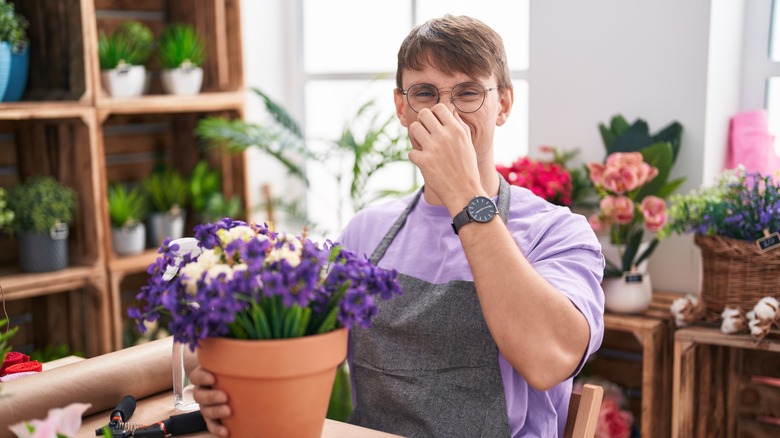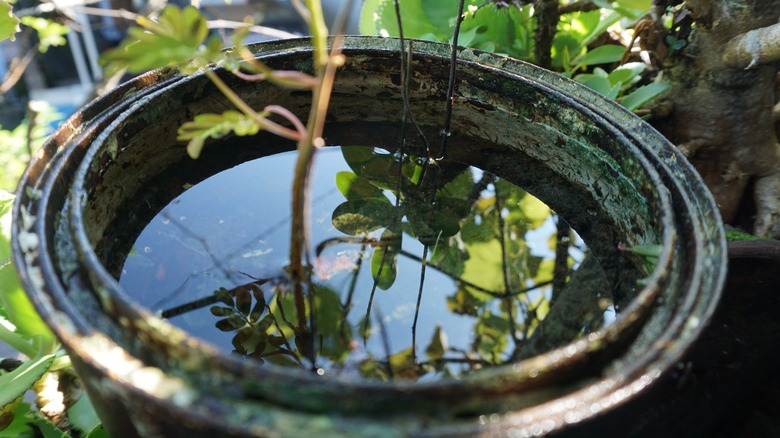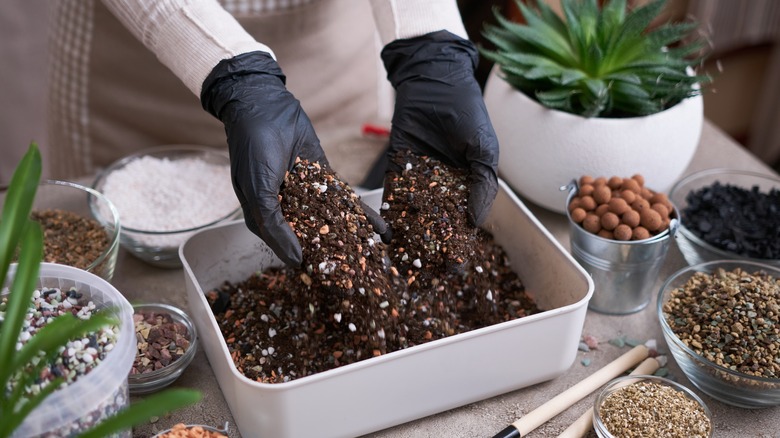If Your Indoor Plants Are Giving Off A Bad Smell, This Is Likely Why
If your plants are brightening your space but stinking up the room, we don't urge you to take a deep breath. Most houseplant owners would never imagine having to deal with a stale-smelling plant. Sure, they may have envisioned brightening up their space, and even given themselves a pat on the back for introducing some greenery into their living space, but a funky plant can be a thorn in the side. This is especially true because there is a definitive link between emotional well-being and the smells of nature, per an article published by the National Library of Medicine. If the unpleasant scents are getting to you, you can start the investigation by checking each plant to trace the source of the rancid aroma. Assuming that the offending culprit is not one of the gorgeous but smelly container plants that should not be grown indoors, you may need to dig a little deeper to find the root cause of the smell.
Diagnosing the cause of the malodor may take some time, but just like with acute halitosis, a long-term solution will yield more satisfying results than masking the smell with a freshener. Interestingly, one of the most common reasons that a houseplant may leave a lingering odor has everything to do with how its owner manages its care. Overwatering your indoor garden or not paying attention to its potting mix are two of the chief causes of your houseplant crying foul.
Overwatering houseplants creates disasters
While you may love your indoor garden, showing it care by overwatering it could result in a host of problems least of which could lead to a nasty aroma. Not only is saturated soil far more prone to foul-smelling fungus, but it could take on an overpowering scent. Besides the stagnant excess water that may have been collected in a drip tray beneath the container, a waterlogged plant may develop root rot. Another issue is that plant pests or fungus gnats deposit their eggs in an environment best suited for them — wet soil. The larvae then feast on the plant roots and other organic matter within the substrate.
Luckily, you can rescue your overwatered flora by trimming and repotting it in a free-draining potting mix in the right container suitable for your indoor plants. Then, after trimming off the damaged sections, water the plants sufficiently. The best way to hydrate most houseplants is to thoroughly drench them with water until no more bubbles appear on the surface. However, some houseplants barely need to be watered, and it's best to research each one's specific requirements. Otherwise, try inserting a wooden dowel into the container. If the potting mix still has enough water, some soil granules will cling to the stick. But if the rod comes up dry, then your plant is ready to be watered. Alternatively, a soil moisture meter is handy to accurately check if your chlorophyll baby needs some hydration.
Soil quality determines a plant's health
Take a good whiff of your houseplant, and try to discern what it smells like. Has it permeated your scentscape with eau de rotten eggs? If the stench of hydrogen sulfide is present, there's a chance that your soil has gone off. If there is poor circulation in the room, anaerobic bacteria may thrive in the wet, dense soil. One of the culprits may be peat moss, which is commonly found in potting mixes. The organic material only lasts a year or two before it decomposes and releases carbon dioxide into the atmosphere. Remedy the situation by repotting your flowers in a container-specific soil that is airy and has a low density, is rich in good microbial matter, drains easily, and has plenty of nutrients. Also, look into an eco-friendly peat-free potting mix to do your bit for the environment.
If you have only recently replaced your planting mix, perhaps your fertilizer has contributed to the unpleasant smells. While organic fertilizers will do wonders for the growth and continued health of your greenery, they may have an off-putting aroma. Mineral fertilizers are scentless and are a viable alternative for indoor gardeners. As a bonus, they will not mask the fragrance of your flowering blooms. If you take the time to troubleshoot why you have a smelly houseplant, even your black thumb may take on a newer shade of green.


